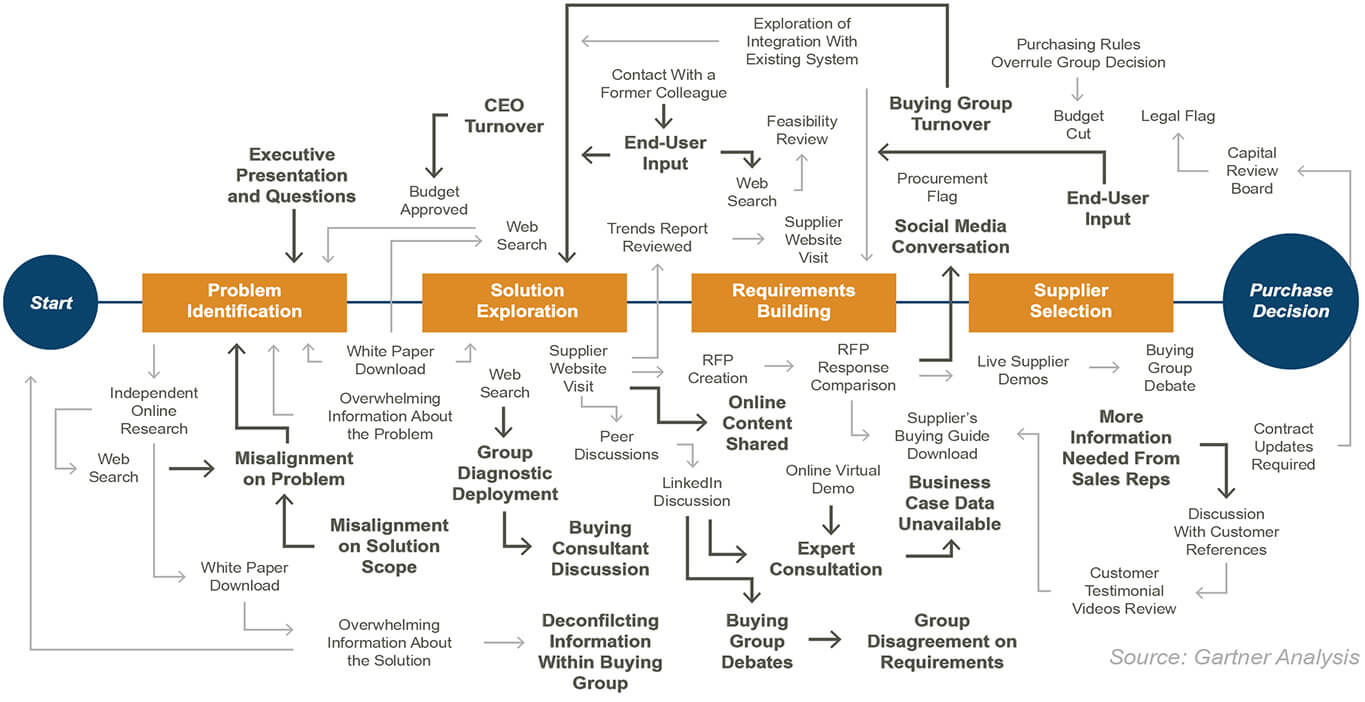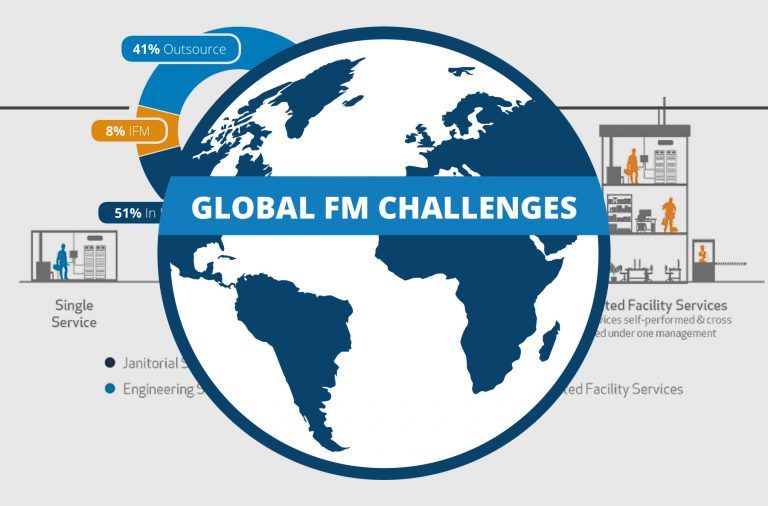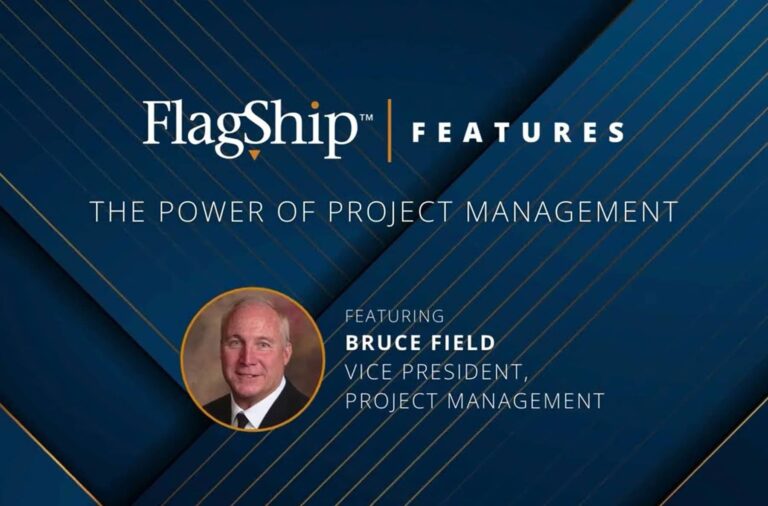At the end of all the meetings, emails, decks, outlines and drafts lives a comprehensive document that outlines exactly what your chosen vendor MUST deliver. The goal then shifts abruptly to securing a provider capable of delivering on those requirements.
- This tried and true method yields the results you seek time and time again… right?
- Through it you’ve become aligned with providers who understand your needs… haven’t you?
- Because of the last RFP, vendors have become partners… haven’t they?
- This process, the RFP process works well… right?
Wrong
Nothing could be further from the truth. The RFP process is broken, and that break starts at the very start of the process – the part where you tell potential vendors how to solve your problem (SOWs and Requirements) instead of presenting the problem itself and requesting actual solutions – and continues throughout vendor selection.
Here’s Why…
Dysfunction Runs Deep
Illustrative B2B Buying Journey
Bold is indicative of always-on “validation” and “consensus creation” activities.

Each step of the RFP process suffers from inertia and each can be improved with small changes in the way you approach a partnership opportunity.
- The RFP team
Everyone might work in the company’s facilities but not everyone should have a say in the facilities services RFP. Input from coworkers whose facilities insight may be limited is a recipe for disaster.
- Service frequencies
Service frequency is an area where miscommunication happens often, and it can cause frustration as well as increased cost.
- Walkthroughs
The pre-bid tour or facility walkthrough is the first opportunity you have to see your potential partner in action as they apply their knowledge to your facilities’ challenges. Treating the pre-bid like a roll call just to tick off a requirement is missing an opportunity.
- Questions and Answers
Information processing, probing, needs analysis and solution crafting takes place at this stage. It’s where potential providers begin to sculpt solutions within the confines of your RFP’s requirements. In many cases, you’re not giving bidders enough time to form those questions. In too many other cases, you’re not giving yourselves enough time to answer them.
- Pricing
In both the public and private sector, the “lowest priced, most responsive” bid is often the goal when recommending a vendor. Deciding to go with the lowest price is not always the best option and opinions vary on the definition of “most responsive” as a final qualifier. It’s accepted though, that low cost providers either have lower profit margins or lower quality services and either way, the level of service will suffer over the life of the contract.
- Evaluations
The matrix that organizations are using to evaluate their RFP responses often doesn’t align with the RFPs requirements or service level standards. This is a serious problem that always presents a challenge to both issuers and responders.
Understand Who You Should Involve
We’ve detailed how the RFP process is wrought with problems but let’s start at the beginning: There are likely too many cooks in your RFP Kitchen! This is the root of the RFP process dysfunction. The truth is, there are only a limited number of employees from specific operational departments that understand the multilayered needs of your facilities. Involving too many opinions makes an often-complex requirements gathering even more complex.

Clearly define your challenge and your goals in your RFP… it’ll help the provider construct a solution specific to your organization.
Download Now!
Take the Request for Proposal Time? white paper with you! Download a PDF version now.
Download PDFLook at it this way. You wouldn’t allow your HVAC person to audit financial statements, would you? Then why is your HR executive involved in the facilities services RFP development process? True, they office in the buildings too. But their understanding of facilities services may be confined to the end result (i.e., a clean HR Training room) versus the solution needed to get that result. Soliciting input from similarly unqualified individuals is a recipe for disaster when it comes to reaching consensus on the RFP’s scope. The remedy is simple. Use a base of stakeholders who understand your facilities challenges and service needs.
Pro Tip
Are most of your vendor questions about conflicting requirements or specifications or incorrect milestone dates and unclear proposal compilation instructions? It may be time to start your RFP document from scratch. This often happens when the tried and true RFP template is trotted out when a new RFP is needed. Your team uses a Find/Replace process to update it to this year’s needs. Unfortunately, after many rounds of review by various department heads throughout the years – all adding their “must haves” to the document – the original, succinct RFP template can become a bloated >200 page document with multiple attachments and appendices and conflicting requirements and instructions.
The cleaner your request and the more streamlined your response requirements, the more responsive your received bids will be.
Are All Services Frequencies Created Equal?
Understanding service frequencies helps get desired results
One reason it’s so important to have the right people building the facilities services RFP is service frequencies. Understanding these frequencies can reduce your final costs and impact the vendor relationship in several ways.
Service frequencies guide how often a particular service is performed on a particular facility asset such as “carpets vacuumed twice a day.” However, carpeting in a rarely used conference room may not require twice a day attention, whereas carpeting in an entryway may need twice a day treatment to stay clean.
During the crafting of your RFP, take the following into consideration
Quality of Service
When frequency expectations aren’t clearly communicated, it will impact the perceived quality of the delivered service. If you’re expecting daily restroom cleanings but your statement of work calls for thrice weekly cleanings, that’s a problem. Communicating frequency expectations clearly limits confusion and forms a solid foundation for KPI success.
Service Dilution
The provider worked hard to secure this contract and they’ll do whatever it takes to maintain it. This includes the diluting service levels in other parts of your facility. When this occurs, your problems begin to reach a critical stage and your facility begins to suffer.
Vendor Churn
Your goal is to choose a vendor that will be a partner in your success. But when service frequencies aren’t clearly articulated, or your vendor’s best practices become a service issue, you’re more likely to be in the market for another vendor as soon as the initial contract period has expired.
Pricing
When service frequency isn’t clearly communicated it has a ripple effect. An unanticipated increase in service frequency impacts the service provider’s bottom line, which can require service or staff reductions as a curative measure. The resulting dissatisfaction or service disruption can ultimately require another round of bid requests to meet the newly redefined service levels.
An early misstep on service frequency expectations can lead the best relationship awry. When it comes to your RFP, be clear in this area. If anything changes, give your provider the chance to adjust. When you take time to do it this way, everybody wins.
Getting to Know Your Facility
A mistake many RFP Committees make is assuming that all facilities are alike. The truth is, they’re different—in some cases, very different. Using an RFP template or relying on information from a consultant may seem convenient, but in the long run, it can prove to be costly. Before writing your RFP, take the time to get to know your own facilities. It could prove to be one of the best investments you’ll ever make.
No two facilities are alike which means no two RFP’s should be alike.
Facilities are different, and no one knows this better than the vendors vying to service them. When it comes to facilities, they’re service experts and understand how to treat every facet of buildings and their infrastructure. But before they can determine your solution, they have to become acquainted with your facilities, your preferences, your target APPA level. This takes place during the walkthrough.
Aside from the compilation of the RFP, the walk-through may be the most important component of your RFP process for several reasons, including:
Bidders and Buildings Introduce Themselves
Bidders are product experts. Before they can use their expertise, a formal introduction must be made. Make sure you choose a knowledgeable person to lead your walk-through. While the potential providers are busy taking notes, you and your team should be taking notes of your own. These can later be shared with members of the RFP Committee during the bid review and selection process.
Multiple Hosts
Having multiple hosts is another option that should be considered, especially when you have a larger facility. One set of eyes and ears can only see or hear so much of what’s going on during the walk-through. Multiple tour guides will give you the opportunity to get more than one perspective on the pool of bidders and the quality of their representatives.
You Get to Know the Bidder
You know your building, but chances are, you don’t know the bidders (save for your incumbent). The walk-through gives you a chance to size them up. Sure, they plan on submitting a response or else they wouldn’t be there. But there are certain cues you can pick up on that the proposal may not cover. Are their questions appropriate? Do they remain engaged throughout the entire walk-through? Can you sense doubt or reservations when certain requirements are discussed? All these are areas that can give you valuable insights.
Learn to respect the walk-through and all it represents. Use it as an opportunity to vet your bidder pool. Listen to the questions the bidders are asking and note how they interact with their competitors on the tour. You’ll gain some insights into their expertise and the level of service they can potentially provide.
Download Now!
Take the Request for Proposal Time? white paper with you! Download a PDF version now.
Download PDFThe Question & Answer Period
Once the walk-through has been completed, bidders need a question and answer period wherein they can seek clarification of your requirements. as they craft your solution(s).
Giving bidders an adequate amount of time to form their questions is a key. Once the walk-through has been completed, they will return to their offices and present your facility challenges to their teams. That’s when lists of questions will begin to form. Your facilities are complex with many layers of needs – be patient with bidders and provide enough of a window to allow them to process all they’ve seen in the walk-through.
Sharing all bidders’ questions and your answers with all bidders is standard practice. Understand that an answer you provide here can give rise to additional questions. Many organizations have a prolonged question and answer process to accommodate additional queries once initial questions have been answered.
Commodity Versus Value
Most procurement departments attempt to select the lowest cost, most responsive bid. While lowest cost is an easy measurement, “most responsive” is not as easily defined.
From a literal perspective, the most responsive bid could be the company that answers every question and provides every requested attachment, appendix and manual. We believe that “most responsive” should equal a demonstrated understanding of your facilities services challenges and a fact-based and proven methodology to meet those challenges – backed by a measurable set of KPIs.
In every RFP bidder pool, there’s always one proposal that has a price that seems too good to be true. It never fails. That low price bid may look like it’s covering all the bases on the surface, but a closer examination of the staff size, their hourly wage rates, the service frequencies, the initial investment in equipment and chemicals, the availability of dedicated on site management often reveals short cuts taken in favor of profit margin.
You’re hiring great people not comparing commodity products.
Before falling into the low price trap, remember the adage that says you get what you pay for. Be willing to put a price on value and experience. Partner with the provider who demonstrates an understanding of your needs and whose company values match your own. while providing value based services.
Your facilities are more than buildings, they are an investment in your staff and your ongoing success. Don’t short change your organization here – investing in proactive facilities services now will ensure that you make the most of that investment in the future.
Numbers Don’t Lie – Unless They Do
Evaluation matrices are extremely important – they seek to remove subjective opinion in favor of objective, qualitative measurement. But, if your matrix hasn’t kept up with your RFP template changes and with the changes in your facilities due to remodeling, expansions, new equipment, you’ll be unable to apply the matrix to your response set to help you identify the winning bidder.
We see all varieties of bid matrices in any given year and we’re accustomed to price being awarded the lion’s share of the weight – often being weighted at > 60%. While we understand that the motivation to outsource is often price driven, we urge caution when giving too much weight to the pricing component of your RFP. Doing so ignores the very real value adds that an experienced facility service vendor brings to the table with industry specific personnel and training, equipment, chemicals and supplies.

What If…
After it’s all said and done, the bid totals are tallied up, a winning bid is selected and several months later, the chosen vendor is not working out and your RFP and its committee take the blame?
What if the next time your facility services required an RFP you:
- Took the time to involve the right people in the development process, yielding a document that allowed bidders to craft solutions, not just check off requirements.
- Made sure the service frequencies were correct. In addition to letting the bidders develop a more accurate price, it would also help you build a partnership, as opposed to hiring a provider.
- You took your time with walkthroughs and understood that they’re valuable interviews that can provide insight, not just a formality.
- Gave bidders more time to ask questions and gave your staff more time to answer them. The Q&A period is important and rushing it can spell disaster to the final partnership.
- You walked into this RFP with an investor mindset, thinking long-term and in the best interest of your facility.
- Revamp the bid matrix and evaluation process to uncover actionable information you could use to make a decision.
But here’s a better question. What if—you killed the RFP altogether? What if you killed the RFP and never spent another minute building that complicated document and instead, you spend that time building true relationships?
It’s Time for a Relationship
Businesses are built on relationships and those relationships start by understanding needs. One of the failings of the standard RFP process is that it’s driven by responses to specific requirements instead of seeking an innovative new way to solve facility problems to meet business needs.
RFP’s, even when knowledgeable people are involved, often miss the mark. When RFPs misstate the facility challenges, place too much weight on price and insist on a particular solution, neither your facility nor the “winning” bidder benefits. The RFP process actually kills the two-way communication that is so important to building partnerships that can create new solutions to old challenges.

Removes the constraints of the RFP
Within the confines of an RFP, every vendor looks the same. But when a needs analysis is used, facility service providers can show their true value in their ability to think outside the box to solve your challenges. As a result, you’re able to do a more accurate assessment of how they mesh with your organization and its goals.
Provides you with new partners as opposed to a pool of best responses
The RFP process often comes down to who crossed their “t’s” and dotted their “i’s” the best, not who came up with the most amazing solutions. With a needs analysis, the service experts are guiding the process, asking probing questions and authoring solutions that you may never have thought of. This is how partnerships are formed and where true value is delivered.
The good news is that Flagship is willing to perform a thorough needs analysis that uncovers hidden areas that have long been ignored due to broken RFP processes. Our needs analysis will point the way to a better solution, staffed with capable professionals who understand how to best service your environment.
Evaluation matrices are extremely important – they seek to remove subjective opinion in favor of objective, qualitative measurement. But, if your matrix hasn’t kept up with your RFP template changes and with the changes in your facilities due to remodeling, expansions, new equipment, you’ll be unable to apply the matrix to your response set to help you identify the winning bidder.
We see all varieties of bid matrices in any given year and we’re accustomed to price being awarded the lion’s share of the weight – often being weighted at > 60% .
While we understand that the motivation to outsource is often price driven, we urge caution when giving too much weight to the pricing component of your RFP. Doing so ignores the very real value adds that an experienced facility service vendor brings to the table with industry specific personnel and training, equipment, chemicals and supplies.
Download Now!
Take the Request for Proposal Time? white paper with you! Download a PDF version now.
Download PDFSubscribe Now!
Stay up to date with the latest facility management tips and news.





